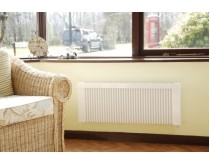How Should You Size Your Electric Radiator?

Electric radiators are convection heaters, which, by their very nature, heat the air around them. The problem is the radiator might not have the power to heat the air, since it's too small, or it's too big and using too much power. To keep your energy bills down and maximise efficiency, you must have the correct size radiator.
One of the biggest mistakes people make is not taking into account the heat loss of a room. They only take into account the size. And this is where knowing radiators are convection heaters comes in handy.
In this article, we will discuss how you should go about sizing your electric radiator.
Fact Finding Mission : To start with, you need to find out a number of key pieces of information about the room you want to heat. The type of radiator does not matter when making these calculations, so you don't need to change anything if you're using vertical radiators.
Find out the following:
- square footage
- ceiling height
- any insulation in the walls
- the number of windows
- the number of fireplaces.
You should use this information online. There are plenty of calculators to help you discover the amount of heat loss in a room. This will ultimately determine the best radiator for you.
For the most accurate results, take these calculations to a professional installer. They will be able to recommend a number of radiators that work for you.
Features and Type : Now you have an estimate about the right sizes of radiator suitable for your room, you need to choose the features. The features you pick can determine how efficient your radiator is.
To start with, your radiator must have a thermostat control. This ensures your radiator only heats as much as it needs to for reaching the desired temperature. Without a thermostat control, it will continue to heat the room, and therefore waste energy.
Other features you should consider depend on the needs of your home, such as safety devices, wheels, and handles for transportation.
Type of Radiator : You may have to purchase a different electric heating boiler system depending on the type of radiator. An electric radiator is a general term used to describe a series of different radiators. There are multiple types you have to consider.
When sizing your electric radiator, you have to consider the following radiator types:
- portable –these tend to be attached to wheels and may not have the same level of power
- wall-mounted radiators, which are the most common types
- baseboard
- wall inset.
Radiator Output : The radiator's output must be determined by converting the wattage of the model to something called British Thermal Units (BTU). You have to convert wattage to this unit because this number takes into account the results gained through intensive room-based testing.
There are a number of free online conversion tools online to help you with this. By using BTUs, you can determine the type of radiator that will have enough power and efficiency after the heat loss of your room is taken into account.
In some cases, you may also discover it is more viable to purchase multiple smaller radiators for larger rooms.
